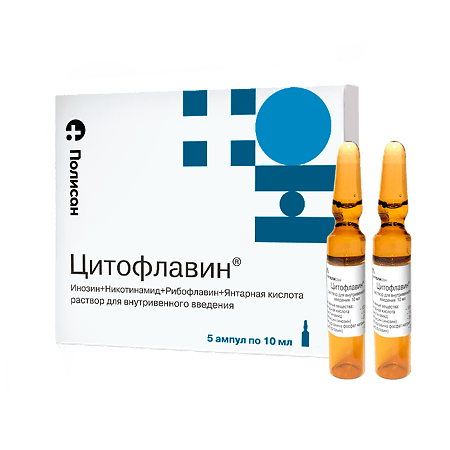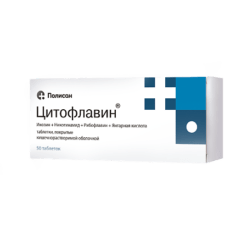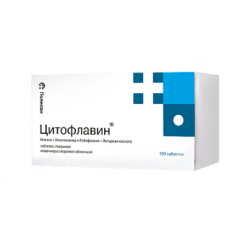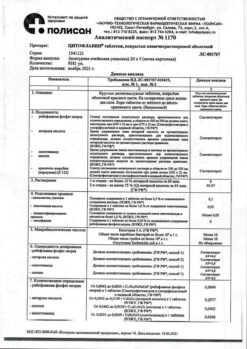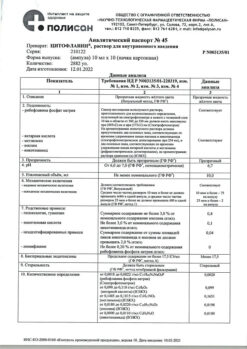No products in the cart.
Cytoflavin, 10 ml 5 pcs
€20.14 €16.78
Description
CITOFLAVIN® promotes the activation of aerobic cell metabolism, which leads to an increase in glucose utilization, promotes increased levels of beta-oxidation of fatty acids and resynthesis of γ-aminobutyric acid in neurons.
CITOFLAVIN® increases resistance of nerve and glial cell membranes to ischemia, which is manifested by a decrease in the concentration of neuro-specific proteins characterizing the level of destruction of the main structural components of nervous tissue.
CITOFLAVIN® improves coronary and cerebral blood flow, activates metabolic processes in the central nervous system, restores disturbed consciousness, facilitates regress of neurological symptoms and improves cognitive functions of the brain. It has a fast awakening effect in post-arrest depression of consciousness.
When administering CITOFLAVIN® within the first 12 hours of the onset of stroke a favorable course of ischemic and necrotic processes in the affected area (decrease of the focus), recovery of neurological status and decrease of the level of disability in the long-term period are observed.
Indications
Indications
In adults in complex therapy:
1. Acute cerebrovascular accident.
2. Consequences of cerebrovascular diseases (consequences of cerebral infarction, cerebral atherosclerosis).
3. Toxic and hypoxic encephalopathy in acute and chronic poisoning, endotoxicosis, post-anesthesia depression of consciousness, as well as for the prevention and treatment of hypoxic encephalopathy during cardiac surgery using artificial circulation.
In children (including premature infants with a gestation period of 28-36 weeks) in complex therapy in the neonatal period:
1. For cerebral ischemia.
Pharmacological effect
Pharmacological effect
CYTOFLAVIN® promotes activation of aerobic cell metabolism, which leads to an increase in the level of glucose utilization, promotes an increased level of beta-oxidation of fatty acids and the resynthesis of γ-aminobutyric acid in neurons.
CYTOFLAVIN® increases the resistance of the membranes of nerve and glial cells to the effects of ischemia, which is expressed in a decrease in the concentration of neurospecific proteins that characterize the level of destruction of the main structural components of nervous tissue.
CYTOFLAVIN® improves coronary and cerebral blood flow, activates metabolic processes in the central nervous system, restores impaired consciousness, promotes regression of neurological symptoms and improves cognitive functions of the brain. It has a quick awakening effect during post-anesthesia depression of consciousness.
When using the drug CYTOFLAVIN® in the first 12 hours from the onset of stroke, a favorable course of ischemic and necrotic processes in the affected area (reduction of the lesion), restoration of neurological status and a decrease in the level of disability in the long-term period are observed.
Special instructions
Special instructions
Administration of the drug to newborn (premature) children is carried out under the control of indicators of the acid-base state of capillary blood at least 2 times a day (both before and during therapy). Serum lactate and glucose levels should be monitored whenever possible.
The rate of administration of a solution containing CYTOFLAVIN® should be reduced or the infusion should be temporarily stopped in newborn (premature) infants:
– those on artificial ventilation, when signs of mixed (respiratory-metabolic) alkalosis appear, which is threatened by the development of cerebral circulatory disorders;
– with preserved spontaneous breathing and respiratory support using the CPAP method or in those receiving an air-oxygen mixture through a mask when laboratory signs of metabolic alkalosis appear, which is threatened by the appearance or increase in frequency of apnea attacks.
In patients with diabetes mellitus, treatment should be carried out under the control of blood glucose levels.
Possible intense yellow coloration of urine.
CYTOFLAVIN® does not affect the ability to drive vehicles.
Active ingredient
Active ingredient
Inosine, Nicotinamide, Riboflavin, Succinic acid
Composition
Composition
1 ml of solution contains:
active substances:
succinic acid – 100 mg,
nicotinamide – 10 mg,
Riboxin (inosine) – 20 mg,
riboflavin mononucleotide (riboflavin) – 2 mg;
excipients:
N-methylglucamine (meglumine) 165 mg;
sodium hydroxide 34 mg;
water for injections
Pregnancy
Pregnancy
It is not recommended to take during pregnancy and lactation due to the lack of clinical data on the effectiveness and safety of the drug during this period
Contraindications
Contraindications
Hypersensitivity, in patients on mechanical ventilation, when the partial pressure of oxygen in arterial blood decreases to less than 60 mm Hg. Art., period of breastfeeding.
With caution – nephrolithiasis, gout, hyperuricemia.
Side Effects
Side Effects
With rapid drip administration, undesirable reactions may occur that do not require discontinuation of the drug: hyperemia of the skin of varying severity, a feeling of heat, bitterness and dry mouth, sore throat.
Rare adverse reactions include: short-term pain and discomfort in the epigastric region and chest area, difficulty breathing, nausea, headache, dizziness, “tingling” in the nose, dysosmia, pallor of the skin of varying degrees of severity.
Allergic reactions in the form of skin itching, transient hypoglycemia, hyperuricemia, exacerbation of gout are also possible.
In children (including premature babies) during the neonatal period, disturbances in the acid-base balance (alkalosis) may develop.
Interaction
Interaction
Succinic acid, inosine, nicotinamide, compatible with other drugs.
Thyroid hormones accelerate the metabolism of riboflavin.
Reduces and prevents the side effects of chloramphenicol (disturbance of hematopoiesis, optic neuritis).
Riboflavin: Reduces the activity of doxycycline, tetracycline, oxytetracycline, erythromycin and lincomycin.
Not compatible with streptomycin.
Chlorpromazine, imipramine, amitriptyline, by blocking flavinokinase, disrupt the incorporation of riboflavin into flavin adenine mononucleotide and flavin adenine dinucleotide and increase its excretion in the urine.
Compatible with drugs that stimulate hematopoiesis, antihypoxants, and anabolic steroids.
Overdose
Overdose
To date, no cases of overdose with CYTOFLAVIN have been identified.
Storage conditions
Storage conditions
In a place protected from light, at a temperature of 0–25 °C
Shelf life
Shelf life
2 years
Manufacturer
Manufacturer
Polisan NTFF LLC, Russia
Additional information
| Shelf life | 2 years |
|---|---|
| Conditions of storage | In a light-protected place at 0-25 °C |
| Manufacturer | Polysan NTFF LLC, Russia |
| Medication form | solution |
| Brand | Polysan NTFF LLC |
Other forms…
Related products
Buy Cytoflavin, 10 ml 5 pcs with delivery to USA, UK, Europe and over 120 other countries.

